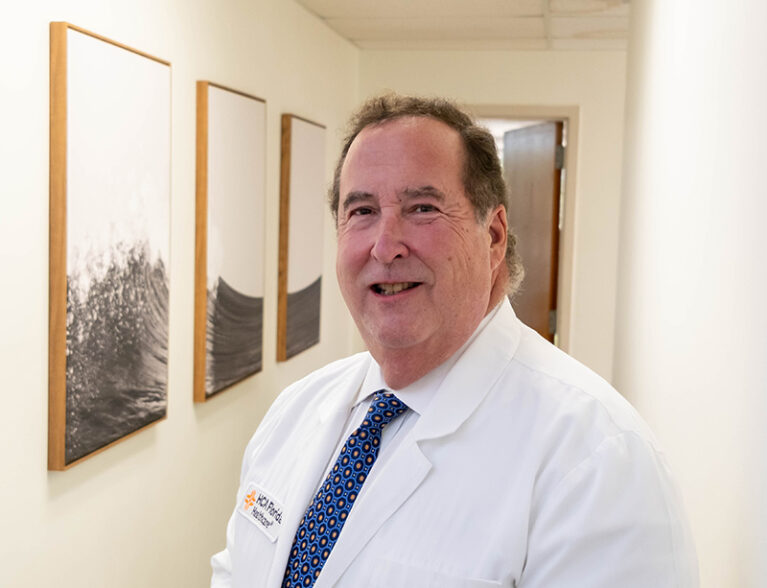
“Oh, it was just a cough.”
Those five words have ended far too many lives. For decades, lung cancer was typically discovered too late, after symptoms appeared and the disease had already spread, leaving patients with few options and little time.
But that’s beginning to change, thanks to one deceptively simple tool – the low-dose CT scan. This powerful yet painless screening catches lung cancers early, saves lives, and opens the door to treatments that weren’t even possible a decade ago.
“By the time you develop warning signs like coughing up blood, chest pain, or shortness of breath, it’s likely already in an advanced stage,” said Dr. Philip Seibel, a cardiothoracic surgeon with HCA Florida Lawnwood Hospital in Fort Pierce, who has seen first-hand how early detection changes outcomes. “Most early-stage lung cancers are found through low-dose CT scan screening, which is a relatively simple test.”
Screening is designed for people who would be candidates for curative treatment if a cancer is found. The U.S. Preventive Services Task Force recommends annual low-dose CT (LDCT) scans for adults ages 50 to 80 who have at least a 20 pack-year smoking history – meaning the equivalent of one pack a day for 20 years – and who currently smoke or have quit within the past 15 years.
“The only way to detect early-stage lung cancer is through screening or incidental findings on an X-ray,” Dr. Seibel explained. “Let’s say you’re going in for a knee replacement, and they do a routine pre-op chest X-ray. If a small nodule shows up, that might be the first clue. At that point, you’d be referred for more definitive testing.”
That’s exactly what modern technology helps hospitals do better than ever before. “We have an artificial intelligence system that flags any lung nodule, no matter how small, on every chest radiograph that comes through our system,” Dr. Seibel said. “A full-time nodule coordinator reviews the images and determines whether it needs referral to a surgeon or just follow-up. We’re now identifying most of our early-stage lung cancers through this AI program.”
Catching cancer early dramatically improves survival. When lung cancer is found while still localized in the lung, five-year survival rates exceed 60 percent. Once it spreads to distant organs, that number plummets to less than 10 percent.
By shifting diagnoses toward earlier stages, screening vastly expands the number of patients eligible for surgery, radiation and other curative therapies, turning what was once a fatal disease into a treatable one.
“The CT scan shows areas of inflammation, infection or tumor,” Dr. Seibel said. “If a nodule lights up, it suggests cancer. It also tells us whether it has spread to the lymph nodes or the middle of the chest. We love to see small, isolated nodules because those are the ones we can cure.”
Once a suspicious nodule is identified, the next step is a biopsy to confirm the diagnosis. “We can do a CT-guided lung biopsy, where the radiologist localizes the nodule and inserts a needle into it to extract cells,” Dr. Seibel explained. “Or we can go from the inside out using a robotic bronchoscope – it’s like having a GPS that lets me navigate directly to the nodule for sampling.”
If biopsy confirms cancer, surgery is often the best course. “We remove the lobe of the lung that contains the cancer and sample all the nearby lymph glands to determine whether it’s spread,” Dr. Seibel continued. “Before surgery, patients undergo pulmonary function tests to see how much lung can be safely removed. That helps us plan treatment and minimize risk.”
Even though the lungs don’t regenerate, the body is remarkably adaptable. “The remaining parts of the lung expand to fill the space, and other structures in the chest shift slightly to help,” he said. “Patients are often surprised at how well they recover.”
But surgery is just one piece of the puzzle. For patients who aren’t good surgical candidates or whose tumors are more advanced, there’s a new generation of therapies. Targeted chemotherapy treatments can home in on specific genetic mutations in the cancer, while immunotherapies stimulate the body’s immune system to recognize and destroy cancer cells.
“Therapies have transformed cancer from a death sentence into a potentially curable disease,” Dr. Seibel declared. “Markers in the cancer dictate which treatments will work best. It’s a very personalized approach based on the tumor’s size, its genetic makeup, lymph node involvement, and the patient’s lung function. For those who can’t tolerate surgery, we can often use highly focused radiation therapy instead.”
That progress means more patients are living long, full lives after diagnosis – something few would have imagined just a generation ago. “Lung cancer is no longer a death sentence,” Dr. Seibel said. “It’s not something to fear. It’s something to face and deal with. These days, we can move from detection to diagnosis to treatment in about 30 days, and many of our patients go on to live normal life spans.”
So, if you have a history of smoking, talk to your doctor about screening. Don’t wait for symptoms to tell you something’s wrong. That “routine” CT scan could be the test that saves your life.
Dr. Philip Seibel received his medical degree at Medical University of South Carolina and completed his residency at Allegheny General Hospital/Carilion Clinic at Virginia Tech School of Medicine. He went on to complete a fellowship at Allegheny General Hospital. His office is located at 2100 Nebraska Ave., Suite 201, Fort Pierce. Call 772-465-8100 for an appointment.



